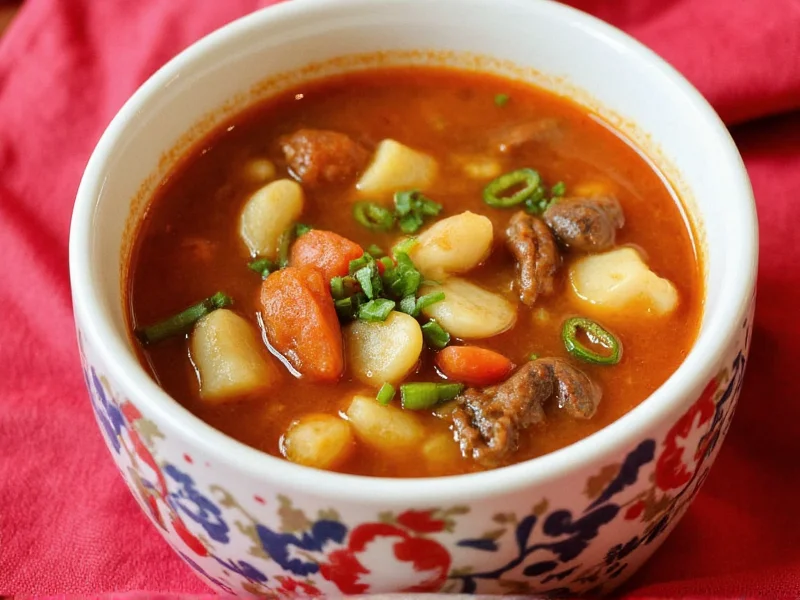Menudo's Historical Roots and Cultural Significance
Menudo traces its origins to pre-Hispanic Mexico, where indigenous communities utilized every part of the animal for sustenance. When Spanish colonizers introduced cattle to the Americas, Mexican cooks incorporated beef tripe into their traditional cooking methods, creating what we now recognize as menudo. The dish evolved as a practical way to use less desirable cuts of meat, transforming them into something flavorful and nourishing through slow cooking techniques.
In Mexican culture, menudo holds special significance beyond mere sustenance. Families often prepare it for weekend gatherings, special occasions, and as a traditional remedy for hangovers—a practice so widespread that many Mexican restaurants feature menudo prominently on Sunday menus. The communal aspect of sharing a steaming bowl of menudo connects people to their heritage and to each other.
Essential Ingredients of Authentic Menudo
The foundation of traditional menudo rests on several key components that create its distinctive flavor profile:
- Beef tripe (callos) - The primary protein, cleaned and sliced
- Hominy (maíz pozolado) - Adds texture and heartiness
- Guajillo and/or chile Colorado - Provides the characteristic red color and flavor
- Garlic, onion, and oregano - Essential aromatics
- Lime wedges - Served on the side for brightness
- Condiments - Typically include chopped onions, cilantro, and oregano
| Menudo Variation | Key Characteristics | Regional Origin |
|---|---|---|
| Menudo Rojo (Red Menudo) | Bright red color from guajillo chilies, robust flavor | Widespread throughout Mexico |
| Menudo Blanco (White Menudo) | No chilies added, clear broth, milder flavor | Central Mexico |
| Menudo con Pata | Includes beef feet for extra gelatinous texture | Northern Mexico |
| Filipino Menudo | Pork-based, tomato sauce, potatoes, raisins | Philippines (Spanish influence) |
Traditional Preparation Methods
Authentic menudo preparation requires patience and attention to detail. The tripe must be thoroughly cleaned through multiple rinsing cycles and often boiled with vinegar to remove any unwanted odors. After cleaning, the tripe simmers for several hours—typically 3-4 hours minimum—until tender.
The chili base forms the soul of red menudo. Dried guajillo chilies are toasted, rehydrated, and blended into a smooth sauce that's then fried with garlic and onions before adding to the broth. Hominy joins the pot during the final hours of cooking, absorbing the rich flavors while maintaining its distinctive texture.
Unlike quick-cooking soups, menudo benefits from preparation a day in advance, as the flavors continue to develop and meld during refrigeration. Many traditional cooks believe menudo tastes best on the second day, which explains why it's commonly served on Sundays after being prepared Saturday night.
Menudo vs. Similar Dishes
While menudo shares similarities with other traditional dishes, important distinctions exist:
Menudo vs. Pozole: Both use hominy, but pozole features pork (typically shoulder or head meat) instead of tripe and has different seasoning profiles. Pozole comes in red, green, and white varieties, while menudo is primarily red or white.
Menudo vs. Mondongo: Mondongo refers to tripe soup in many Latin American countries but typically has different spice profiles and additional ingredients like vegetables or plantains, varying significantly by region.
Menudo vs. Filipino Menudo: Despite the shared name, Filipino menudo is a completely different dish—a tomato-based pork stew with potatoes and raisins that reflects Spanish culinary influence in the Philippines rather than direct connection to Mexican menudo.
Serving Traditions and Accompaniments
Menudo is traditionally served piping hot in deep bowls, often accompanied by specific sides that enhance the eating experience:
- Tortillas - Warm corn tortillas for dipping or making impromptu tacos
- Lime wedges - A squeeze of fresh lime brightens the rich broth
- Oregano and chopped onions - Added to taste for aromatic complexity
- Chopped cilantro - Provides fresh contrast to the hearty stew
- Chili sauce or flakes - For those who prefer additional heat
In many Mexican communities, menudo is considered a social food, often enjoyed communally at family gatherings or at specialized menudo restaurants that open early on weekends. The ritual of customizing each bowl with preferred condiments is part of the cultural experience.
Common Misconceptions About Menudo
Several misconceptions surround menudo that deserve clarification:
Menudo as solely a hangover cure: While many enjoy menudo after celebrations, its cultural significance extends far beyond this single use. It's a cherished traditional dish with deep roots in Mexican culinary heritage.
Difficulty of preparation: While authentic menudo requires time, the actual cooking process involves relatively simple techniques. The extended cooking time primarily serves to tenderize the tripe and develop flavors.
Universal recipe: Menudo varies significantly by region and family tradition. What constitutes 'authentic' menudo differs between Mexican states and even between households, reflecting the diversity of Mexican cuisine.











 浙公网安备
33010002000092号
浙公网安备
33010002000092号 浙B2-20120091-4
浙B2-20120091-4